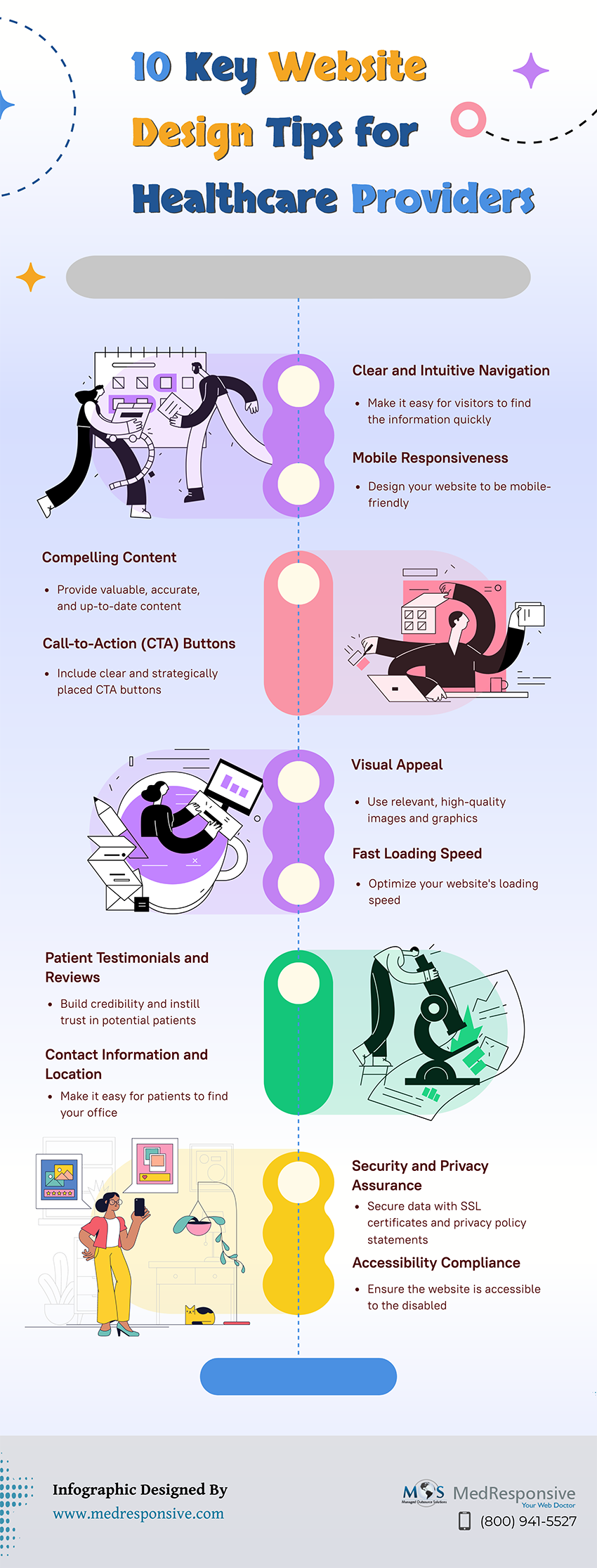Patients increasingly rely on healthcare websites for many things right from symptoms checking, remote consultation, to locating nearby healthcare providers, scheduling appointments, and paying bills. Therefore, it is important for healthcare organizations to design and develop a dynamic and useful medical website. A website is the first point of contact between a patient and a healthcare practice. It plays a key role in enhancing user experience. The first impression that this encounter imparts can create a long-lasting impact on patients and build brand reputation and profitability in the long run. Hospitals often have a large amount of information to present on their website. Not following current design standards will make the website quite incompatible with or complex to browse on mobile devices and smartphones. Healthcare website development services provided by professional firms focus on creating innovative designs with unique content that helps healthcare practices improve their online visibility.
Web Design for Enhanced User Experience
Designing a responsive website for healthcare facilities can be challenging due to the vast amount of information they need to present. Striking a balance between providing comprehensive content without overwhelming visitors can be tricky. Additionally, many hospital websites, created years ago, no longer meet present-day design standards, which makes them incompatible with mobile devices. Professional medical website design services can offer innovative solutions with unique content to enhance a healthcare practice’s online visibility.
Hospitals need to adhere to web design standards tailored to their specific needs. It is vital to understand that many visitors may be experiencing emergencies or seeking information urgently before a visit. Easy navigation, centralized access to commonly sought information, and mobile device compatibility are critical components for hospital website design. By incorporating these, healthcare websites can efficiently serve those in urgent situations, ensuring seamless access to essential information and services, and ultimately, preventing potential patients from seeking help elsewhere.
Remember to regularly update your website with new content and features to keep it fresh and engaging for your audience. A well-designed healthcare website can not only attract new patients but also help build long-lasting relationships with your existing ones.
We have listed some good website design strategies below that you can utilize for the best results.
- Add High-Quality Content: One of two things is probably happening when a user visits a healthcare website: either they are transacting business or, more likely, they are obtaining information. Your website should include robust content management features, such as an enormous library of text and video resources covering health-related themes, to support such actions. Make sure your website has high-quality materials and information that establish you as a pioneer in patient-centered clinical care and medical education. Ensure that your messaging is well-informed and easy to understand so that it will be useful to all kinds of people.
Want to know the different types of content that can drive more traffic?
Read our blog post Types of Content That Can Drive Traffic to Your Website in 2024
- Ensure visual appeal: For this, incorporate high-quality images and graphics in your website content. Visual appeal is a very important requirement for your website, and helps retain visitors on your site.
- Don’t complicate things: Websites for healthcare frequently have anxious visitors. A cluttered, confusing website that is difficult to use won’t help ease the worries or frustrations associated with their present or anticipated health problems. The last thing that your website visitors will want to see are thick text walls and technical jargon. Consistent, lucid material benefits users more. Your objective should be to minimize user thought as they navigate your website. Make sure the website is not extremely text-heavy, and has straightforward content and design.
- Make accessible website design a top priority: Over 44 million Americans, or 13.4% of the total population, live with a handicap, according to the 2021 handicap Statistics Annual Report. For these folks, interacting with websites to make an appointment, complete a basic form, etc., could be difficult, if not impossible. Your website is not accessible to those who are unable to use it due to a disability that impairs their hearing, vision, or physical abilities (including advanced age). Given the serious legal repercussions associated with ADA liability, it is only prudent for businesses to think about developing an accessibility compliance strategy. It is also required for government agencies or groups that get government funding.
-
Contact details that are easily accessible: As was already noted, many people visit websites about healthcare in search of information. One of the first things a patient or their loved one will do is to find location information. Make sure it doesn’t cause them any difficulty or frustration! Some of the information that people look for are:
- searching medical issues
- Understanding the specializations and capacities of a healthcare system
- Looking up physicians
- Obtaining location details
Include some crucial sites, including FAQs, a location page, and a directory, that will address patients’ issues in advance in an effort to anticipate their questions. This will benefit your company as well because it will free up staff time to address frequently asked queries like location, hours, and other details.
- Quick-loading: In the healthcare industry, where users commonly seek out immediate information or assistance, website performance is critical. Fast loading times are crucial for preventing user annoyance and lowering bounce rates. This entails using methods to speed up page loads, like caching, minifying code, and image optimization. Healthcare websites may provide a seamless user experience and increase visitor happiness and engagement by emphasizing rapid loading speeds.
- Mobile responsive website: Healthcare websites must be responsive to mobile devices due to the increasing use of smartphones and tablets. No matter how a person accesses the website, a mobile-responsive design makes sure that it adjusts fluidly to different screen sizes and devices, offering a consistent user experience. In addition to increasing customer satisfaction, responsiveness also benefits search engine rankings because mobile-friendly websites are given preference in search engine results.
- Call-to-Action (CTA): Well-crafted CTAs are crucial for directing website users to take the desired actions, such as making an appointment, getting in touch with the doctor, or subscribing to newsletters. To promote user interaction, calls to action (CTAs) should be thoughtfully positioned around the website and written in an enticing manner. On healthcare websites, strategically placed call-to-actions (CTAs) can increase conversion rates and foster user engagement. Examples of such CTAs include a noticeable “Book Now” button on the homepage and a discreet “Learn More” link in a blog article.
-
Employ advanced data security
In order to ensure that your website complies with HIPAA, consider the following crucial steps to protect patient data:- Make use of an HIPAA-compliant web server that is safe, responsive, and encrypt all of your website’s contact forms, chatbots, and appointment services securely.
- To guarantee an encrypted connection between the browser and the website, secure it with an SSL certificate.
- Obtain each vendor’s signature on a business associate agreement.
- Do regular backups of all PHI.
- Create and put into effect policies and processes for receiving, transferring, deleting, and storing PHI.
- Even if it’s simply in the footer, include a notice of privacy practices and your HIPAA policy.
- All those having access should receive training on HIPAA compliance.
- Patient Testimonials and Reviews: Including real patient reviews and testimonials on a healthcare website can make a big difference in its legitimacy and dependability. Positive testimonials from contented clients can reassure potential clients, and provide them confidence when selecting the medical professional or service. Patient testimonials and reviews can help to establish trust and create a strong bond between the healthcare practitioner and their audience by presenting real-life experiences and results.
Optimize your website’s online visibility and provide a seamless experience for your patients.
To stand out among other competitors, it is important for practices to create a stylish and unique medical website design with valuable content. An experienced provider of medical SEO services can design an aesthetically appealing website for you with distinctive content. This will help increase the search engine rankings and patient acquisition rate dramatically. As the patient inflow increases, the competition among healthcare providers will also increase.





